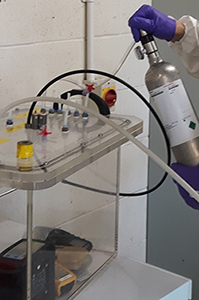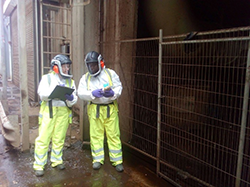 By David N Johnson & Graham Howell, The Open University
By David N Johnson & Graham Howell, The Open University
The importance of fitting the correct sensors for carbon monoxide monitoring in enclosed composting facilities has been highlighted by recent research conducted by the Open University, in collaboration with Amey Ltd. The research was commissioned due to concern about the frequency of alarm activations from carbon monoxide personal safety monitors within the composting facility of an MBT (Mechanical Biological Treatment) plant. Further investigation confirmed the presence of carbon monoxide in the compost hall, though at levels below the 30 ppm alarm threshold. However, non-hazardous levels of hydrogen were also present and caused interference to gas safety monitors, leading to false alarms for high carbon monoxide.
The poisonous effects of carbon monoxide are well known and occupational exposure limits are set by the Health and Safety Executive[1]. Previous research has shown that carbon monoxide can be produced during composting, in MBT plants, other large-scale composting, and laboratory studies [2-4]. Consequently, at Amey waste processing sites and elsewhere, carbon monoxide is monitored to ensure the safety of employees, visitors and contractors. Commonly this is achieved using personal gas safety monitors.
Safety monitors typically use an electrochemical sensor to measure carbon monoxide and these are commonly affected by hydrogen and other gases. Manufacturers provide approximate interference factors[5, 6], though acknowledge that responses vary between models and individual sensors[7, 8]. Whilst no published research was showing that hydrogen is produced during composting was identified, hydrogen is produced during anaerobic decomposition, for instance in landfill and biogas production. It is therefore reasonable to expect that hydrogen can be produced in anaerobic microsites within compost.
Research carried out by a team from the Open University, led by Graham Howell, has confirmed that hydrogen gas is produced during composting at the site monitored, and that this can significantly interfere with some carbon monoxide sensors. A survey of compost exhaust gas measured levels of hydrogen averaging over four times higher than levels of carbon monoxide. Concentrations of hydrogen up to 150 ppm were recorded. At this level, hydrogen is not considered hazardous, but may cause false carbon monoxide readings.
A variety of commercially available carbon monoxide safety monitors were exposed to a range of known carbon monoxide and hydrogen concentrations in a gas-tight box. Most were shown to respond to hydrogen to some degree, though with a range sensitivity. A monitor using a hydrogen-compensated carbon monoxide sensor, as used for landfill and biogas applications, had the lowest response to hydrogen (2%, i.e. 100ppm hydrogen produced a reading of 2ppm carbon monoxide). Other safety monitors gave carbon monoxide readings between 7% and 22% of the concentration of hydrogen applied, in absence of carbon monoxide.
 The effect of the hydrogen gas on the carbon monoxide sensor is to inflate the reading, resulting in unnecessary alarms and evacuations. This can have a detrimental effect on production efficiency and, worse, may result in alarm fatigue, whereby personnel start to ignore alarms because they expect them to be false.
The effect of the hydrogen gas on the carbon monoxide sensor is to inflate the reading, resulting in unnecessary alarms and evacuations. This can have a detrimental effect on production efficiency and, worse, may result in alarm fatigue, whereby personnel start to ignore alarms because they expect them to be false.
The research team concluded that carbon monoxide safety monitors used in composting halls should always be fitted with sensors which compensate for the presence of hydrogen in the atmosphere being monitored.
Further detail on the findings of the research can be obtained from Graham Howell at Ecosystem Laboratories, School of Environment, Earth and Ecosystem Sciences, Faculty of Science, Technology, Engineering and Mathematics, The Open University, Walton Hall, Milton Keynes, MK7 6AA, Tel: +44 (0) 1908 655487
References
- HSE, EH40/2005 Workplace exposure limits Containing the list of workplace exposure limits for use with the Control of Substances Hazardous to Health Regulations (as amended). 2005.
- Haarstad, K., O. Bergersen, and R. Sørheim, Occurrence of Carbon Monoxide during Organic Waste Degradation. J. Air & Waste Manage. Assoc. , 2006. 56: p. 575–580.
- Hellebrand, H.J. and W.-D. Kalk, Emission of carbon monoxide during composting of dung and green waste. Nutrient Cycling in Agroecosystems, 2001. 60: p. 79-82.
- Phillip, E.A., et al., Emission of Carbon Monoxide During Composting of MSW.pdf>. Compost Science & Utilization, 2011. 19(3): p. 170-177.
- Crowcon, Gasman Personal Single Gas Monitor User Manual (Issue 11) 2015.
- MSA, Carbon Monoxide Sensor Cross-sensitivities Alcohols, VOCs & Hydrogen. 2013: PA 16066 USA.
- Austin, C.C., B. Roberge, and N. Goyer, Cross-sensitivities of electrochemical detectors used to monitor worker exposures to airborne contaminants: false positive responses in the absence of target analytes. J Environ Monit, 2006. 8(1): p. 161-6.
- Crowcon. 2014 5/12/2017]; Available from: https://www.crowcon.com/blog/cross-sensitivity-of-toxic-sensors-chris-investigates-the-gases-that-the-sensor-is-exposed-to/